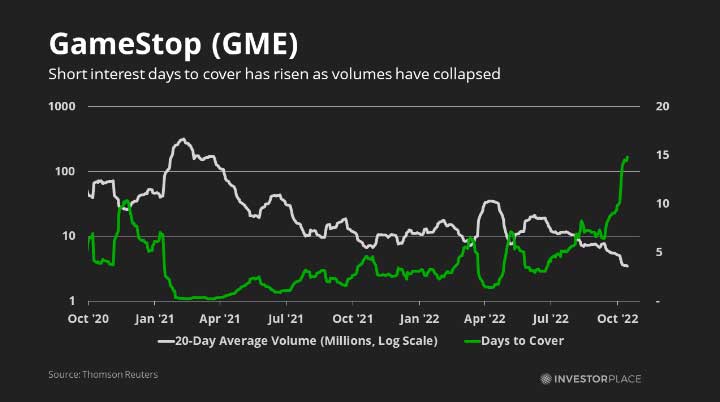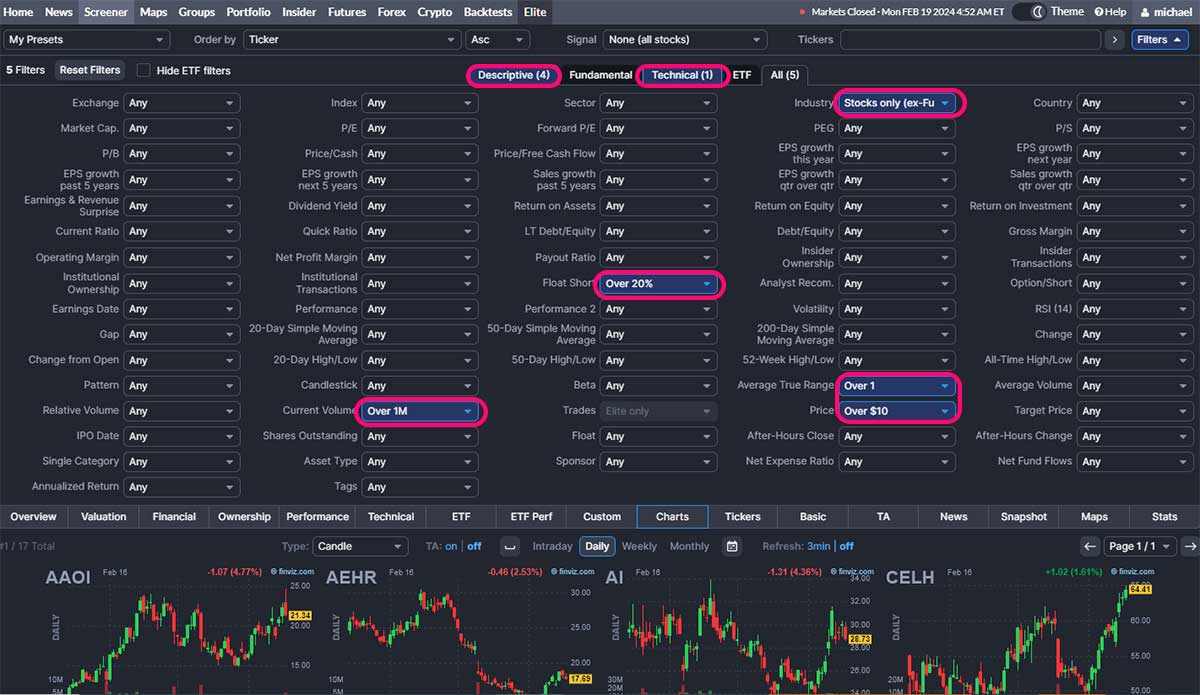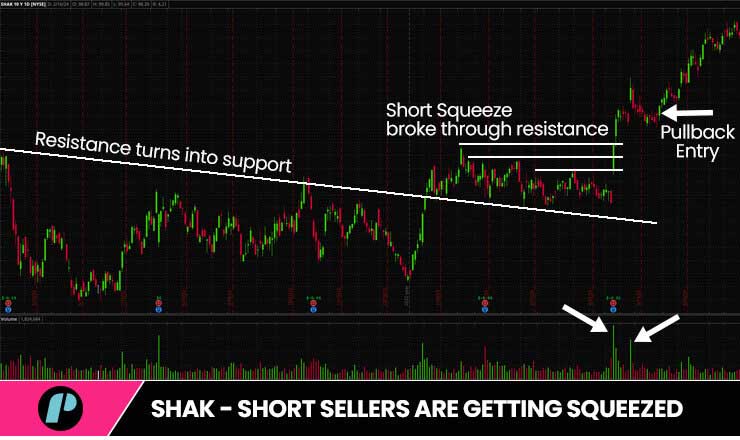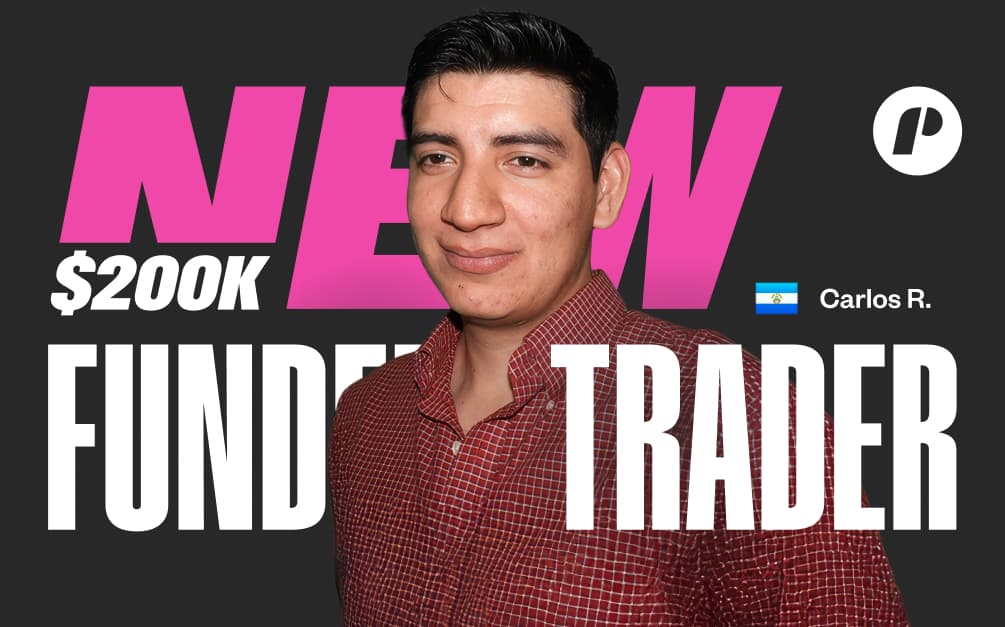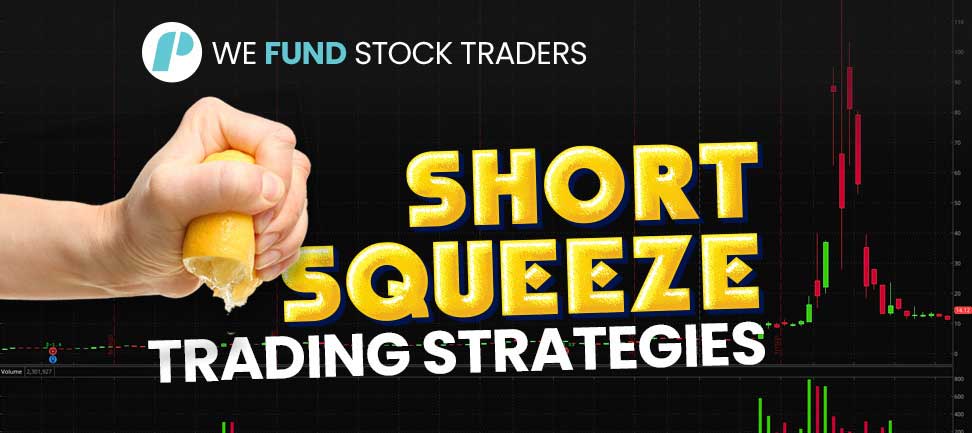
Introduction
Short squeezes have always been a part of stock market trading but it’s only in recent years that short squeeze strategies have become such a hot topic.
A short squeeze occurs when a heavily shorted stock begins to move higher, prompting short sellers to cover their positions by buying some or all of the shares they previously borrowed and sold, which in turn pushes the stock price even higher.
This can create a frantic buying frenzy that attracts new buyers which, again, causes even more short sellers to receive margin calls, forcing them to cover an even larger portion of their position.
Needless to say, this entire process often results in massive gains for those smart (or lucky) enough to find themselves positioned on the right side of the trade.
In today’s article, we’ll explore the intricate details of short squeeze strategies, explaining what they are, how they work, and how stock traders can potentially take advantage of them.
Key Notes
- A short squeeze occurs when a heavily shorted stock starts moving upwards
- As price keep moving higher, more and more short positions must be covered
- Short sellers covering their position in turn pushes price even higher
Understanding Short Squeezes
Before we dive into short squeeze strategies, it’s important to have a clear understanding of what a short squeeze actually is.
In a previous article on short selling we explained how when traders have reason to believe that a stock’s price is about to fall, they often try to profit from that price fall by short selling (or shorting) the stock in question. And, as we discussed in that same article, this involves borrowing shares of a stock from a broker and immediately selling them with the intention of buying them back later at a lower price and pretty much pocketing the difference.
But what happens if price start moving upwards rather than keep falling?
Well, that’s exactly how a short squeeze usually begins.
As we mentioned in the introduction, if the stock price starts to rise instead of fall, short sellers may face mounting losses and a potential margin call from their broker. As a result, they often end up being forced to buy back shares to cover their short positions in a rush, which can drive the stock price even higher, starting an inevitable chain reaction. This chain reaction of buying can lead to a short squeeze, causing significant price spikes in a short period of time and huge profits for early buyers.
What’s a Short Squeeze trading strategy and how do I create one?
Simply put, short squeeze-based strategies are trending techniques adopted by traders to anticipate and profit from the exploding bullish price movements that a short squeeze often provokes.
When creating and applying a short squeeze strategy, traders will normally attempt to:
Identify a stock with characteristics that make it prone to a short squeeze
Not all stocks are equally susceptible to short squeezes. There are certain characteristics that can make some stocks more likely than others to experience a short squeeze scenario; these, for example, may include:
(Image taken from investorplace.com)
High Short Interest Ratio
The Short Interest Ratio indicates the average number of days it takes short sellers to re-buy the stock shorted and cover their positions based on the daily volume.
A short interest ratio of 5 or above could cause short sellers to panic and trigger a short squeeze.
Low Float
A low float refers to a stock with a relatively small number of shares available for trading. (i.e. total stock in circulation minus stock borrowed to be shorted).
A low-float stock may be more susceptible to rapid price movements, especially if there is a high level of short interest.
Potential Catalysts
Traders should research and analyze potential catalysts that could trigger a short squeeze in the identified stock. This could include upcoming earnings reports, positive news developments, or changes in market sentiment. Stocks with positive developments, can attract buying interest and fuel a short squeeze.
How to scan for the right squeeze
You can use these parameters to find the best stocks for short squeeze-
Key Notes
- Interest ratio: it indicates the number of days that it will take short sellers to cover their positions considering the average daily volume.
- :Float: represents the amount of stock still in circulation after the shorted stock has been borrowed and made unavailable)
- Catalyst: it refers to any event, news, announcement, or anything that could spark the initial price reversal necessary for a short squeeze.
Monitor market conditions
Traders need to closely monitor market conditions, including changes in short interest, trading volume, and price action of the targeted stock. This ongoing monitoring is crucial for identifying the right timing to enter the trade and capitalize on the short squeeze.
A stock price often experiences a notable increase in volume and volatility before a short squeeze. Directional volume indicators, in particular, might show stable or decreasing selling volume and increased buying volume. This could be one of the first and most important signs especially when following some sort of catalyst.
Planning, executing, and managing the trade.
Once a potential short squeeze opportunity is identified, traders should develop a clear plan for entering and exiting the trade. After the initial price reversal, for example, traders may decide to set their entry point just above the last lower high and the stop loss at the last lower low. In all cases, however, this plan should include setting price targets, stop-loss orders, and determining the amount of capital to be invested.
When the conditions align with the planned strategy, traders can execute the trade by going long on the heavily shorted stock. This involves buying shares with the anticipation that the price will continue to rise due to the short squeeze dynamics.
It’s important for traders to closely manage the trade by continuously assessing the stock’s price movement and adjusting their exit strategy if necessary. Traders should be ready to consider taking profits as the stock price rises, creating a trailing stop loss order, or even cutting losses if the trade moves against expectations.
Traders should also have a clear exit strategy for closing the trade and realizing the profits from the short squeeze. This could involve selling the shares at predetermined price targets or using trailing stop-loss orders to protect gains.
Key Notes
- It is almost impossible to identify a short squeeze early with certainty
- Usual price action and market conditions can sometimes be mistaken for early signs of a short squeeze
- Price reversals during a downtrend are common but seldom the start of a short squeeze.
Here’s the problem with short squeeze strategies
Yes, there is a problem when it comes to creating a short squeeze strategy.
We have just seen how traders attempt to identify and anticipate the earliest signs of a short squeeze but there is a “but”. And it’s a big “but”. And I sure didn’t write that “attempt” in bold for nothing.
Studies about short squeeze
Studies show that the truth is short squeezes are extremely hard – if at all possible – to be identified in good time and the reason is really simple.
Big short squeezes (and long squeezes too) don’t occur as often as one might think. When they do, they immediately create noise in the media as well as in the market and this, often, can create the impression that they happen more often than they actually do. On the other hand, down trends (sometimes extreme) and bull runs are both very common and plentiful in the stock market.
This inevitably means that on a huge number of occasions (much more often than not) downtrends are momentarily interrupted by temporary reversals that might show off the same sign as a short squeeze only to then reverse again with price moving further downwards.
It is true, for example, that a stock with a high short interest ratio is more prone to a short squeeze because more short sellers would have to cover their positions but it is also true that in the majority of cases, stocks with high short interest are more likely to keep on their downward trend than making a reversal. Even bear/bull traps and dead cat bounces seem to occur way more often than short squeezes.
Studies also reveal that any attempt to satisfyingly create and back-test any short-squeeze strategy has failed to provide conclusive and reliable results.
In other words, a short squeeze is often only identified after it has occurred…. Unless you are the one who provokes it, of course.
But hey, don’t let that put you down
ven knowing that you might be wrong more often than not, with a good money and risk management system, you’d still be able to risk a little if you suspect a short squeeze is imminent. Especially considering the amazing risk/reward ratio that a short squeeze can offer.
So, seriously, don’t let this put you down but do your own due research. Always!
I hope this helps.
If you liked this post make sure to share it!
